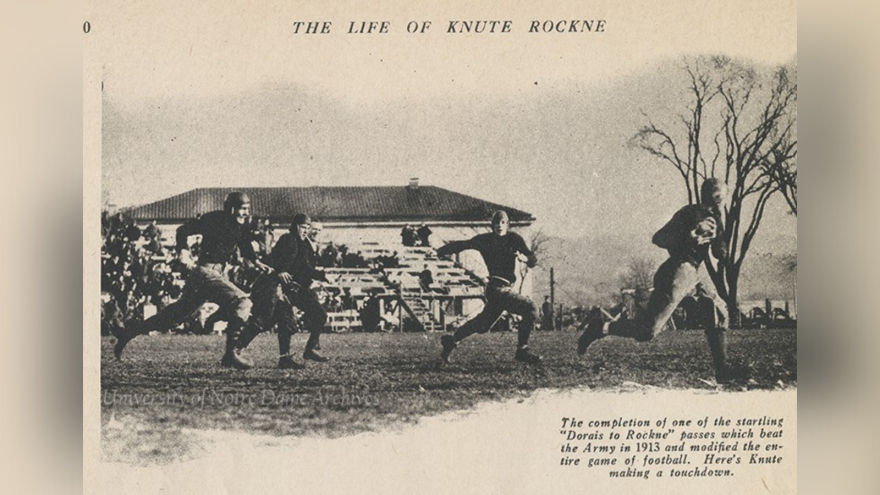Fighting Irish Flashback: Notre Dame breaks ground through the air against Army
 © Photo courtesy of Notre Dame Archives
© Photo courtesy of Notre Dame Archives It's only fitting that our first installment in the 'Fighting Irish Flashback' series features the game that put Notre Dame on the map. The Fighting Irish were flying well under the radar leading up to their 1913 clash against Army on November 1, 1913. Notre Dame was coming off three impressive victories against lower-tier opponents in the weeks leading up to the historic contest, but their matchup with Army, which had been a college football powerhouse at that time, represented their first real test. They needed to create a solid game plan to pull off the upset, and they did exactly that.
The forward pass was a rarely utilized tactic in the early 20th century. In fact, it had just been legalized (in an attempt to improve player safety) seven years before the iconic 1913 clash. However, legendary Notre Dame receiver Knute Rockne and quarterback Gus Dorais practiced the play in the offseason, and they were eager to test out the technique once the games started to count. Their matchup with the prestigious military academy presented the perfect opportunity to put their game plan into action.
Notre Dame had not yet established itself as a formidable opponent. If the game had taken place a century later, Army would have been favored by double-digits. A known commodity against a mid-tier opponent making a long trip? The game had all the makings of a blowout. A story in the New York Times said, 'The Army hopes to defeat Notre Dame by a decisive score tomorrow and thus secure confidence to themselves and their supporters.'
The Fighting Irish wasted no time putting their game plan to the test, as their aerial attack was on display early and often against an unprepared Army defense. They got off to a quick 7-0 lead after Rockne scored on a 40-yard touchdown in the first quarter, stunning both the Cadets' defense and the crowd of around 5000 that gathered at West Point for the game.
“There had been no hurdling, no tackling, no plunging, no crushing of fiber and sinew." Rockne later recalled when giving his take on the play. "Just a long-distance touchdown by rapid transit.”
The Cadets remained competitive throughout the first three quarters but had no answer for the offensive explosion in the fourth quarter. Notre Dame was nursing a 14-13 lead going into the final period before pulling away with three quick touchdowns in the fourth. Army may have been heavily favored before kickoff, but 60 minutes later, they were shell-shocked, which was evident in the final score.
35-13
Notre Dame's blitzkrieg marked the first time a team was so thoroughly dominated through the air, as the Cadets didn't have a single answer for their offensive attack. Senior quarterback Gus Dorais finished the game with 14 completions off 17 attempts, 243 yards, and three passing touchdowns. Many of those completions went to Knute Rockne, the man he practiced the previously taboo offensive attack with so much in the offseason. Their unique strategy helped them score an upset of massive proportions, which was crucial to both their legacy and the legacy of Notre Dame.
The Fighting Irish were no longer an unknown following the upset victory, and the forward pass immediately became a staple of offenses across the nation. Rockne was a member of the inaugural College Football Hall of Fame class in 1951, and Dorais joined him three years later.
The improbable victory spawned a rivalry that spanned several decades. In fact, they faced off every year until 1948 save for 1918, when their annual matchup got canceled due to World War I. The clash was called 'The Game' amongst Fighting Irish faithful. The two teams have since faced off more sparingly, and Notre Dame leads the all-time series 39-8-4, with the Cadets most recent win coming in 1958.
Notre Dame is considered the pioneer of the forward pass, which is a testament to just how iconic their 1913 clash was. Rockne later went on to coach at the school, and it's somewhat ironic their stadium, which was constructed in 1930 under his lead, is referred to as the 'House that Rockne Built,' since he was also crucial in raising the program from the ground up 17 years prior. On November 1, 1913, David defeated Goliath, and the Fighting Irish have never been looked at the same since.
